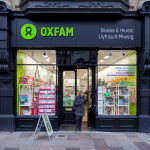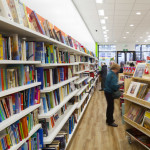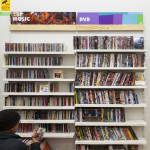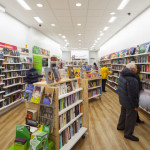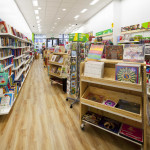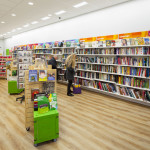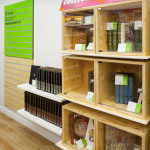Thinking mobile: how should portable technology be integrated into stores?
Triplar Project Manager Alastair Jones discusses the role of mobile technology in modern stores.
“Where can we permanently positon an iPad in-store?” This is not an uncommon request from clients who are keen to integrate tablet technology into their stores, showcasing native applications or ecommerce stores. But does this kind of thinking miss the point?
A fixed unit for a tablet, complete with power supply, is not an uncommon request. Retailers want to use portable technology in taking a multi-channel approach to their retail operations, but then implement it in a 20th Century way – assigning it to a corner of the shop floor, or as an extension of the cash desk.
I would suggest that understanding how these technologies can be used as intended makes far more sense. If you are discussing a jacket or shoes and don’t have it in the right colour or size, would it not
be best to bring this technology over to where the customer is? Retailers are beginning to do this more, but there does seem to be still some misunderstanding as to what this technology can do.
No doubt, retailers are spending a lot of time and effort honing the retail experience within their stores; with increased focus on design, brand, layouts and staff training in recent years. But the application of technology within the store does not seem to have moved on apart from the occasional brand or flagship store doing something unexpected (and usually gimmicky) with technology.
Structural changes in retailers, with investment in the ‘360 degree retailer’ and ‘clicks and mortar’ has given a rise to increasingly sophisticated multichannel and click and collect services – but translating this in-store has beguiled even the biggest brands.
Effective Wi-Fi management and charging also means tablets have the potential to be truly mobile and fulfil roles that entirely subvert conventional retailing. In the US a number of chains are using tablets as part of their till operations, doing away with the cash desk and queueing. And as card transactions continue to outstrip cash payments this will make increasing sense.
Making the shopping experience easier for the shopper is always going to be beneficial and yield a more favourable experience. And using tablet computers and other associated technology to either provide further information, options or to make the sale more quickly is going to be a huge positive.
Triplar has ‘BIM’ developing its design offering
As previously announced, Triplar has put considerable time and resource into incorporating BIM methodology in design projects.
Building Information Modelling (BIM) is a process involving the creation and management of digital models of buildings. The methodology is aimed at managing a building’s entire lifecycle: from design through to maintenance and its refurbishment or redevelopment.
Triplar has been exploring BIM for some time, and the CAD team can now fluently work on Revit models as part of a BIM project.
The team is now working towards becoming BIM-enabled (Level 2), which will involve training throughout the business to embed the methodology on a company-wide basis.
The Dark (and Light) Art of Architectural Photography
Diane Auckland, of Architectural Photography agency Fotohaus, explains the art of architectural photography.
Architectural photography is all about light (and occasionally dark). Daylight, ambient light, building lights, skylights, interior lighting, landscape lights, street lights and even moonlight can play an important part in the composition of images.
As photographers we choose particular angles and frames to show off a space, creating shape, form and patterns to highlight the visual elements.
The other peculiarities of photography; capturing a slice of time, specific focus, depth of field (shallow focus or everything in focus), choice of lens, and, with architectural photography, the use of a view camera or tilt/shift lenses to control the perspective (no converging verticals); all of these elements, along with the all-important light, can combine to create a great aesthetic.
The use of artistic rules, like the rule of thirds, lead in lines or a perfectly symmetrical image, guides most shoots, but we occasionally just abandon all that because something strange or just plain weird looks better than anything else.
Although everyone who commissions us wants to see their whole project in full, a wide sometimes unbelievable panoramic of a shot, often it is the sectional or detail that teases or intrigues and becomes the defining picture of a building or space.
In the end, the added element is the people that use the space; evident occasionally in blurs as they bustle through the space or small enough to remain unknown but big enough to suggest scale, they add a special ingredient to a picture that brings the building to life. And ultimately, they are the purpose of the building.
Supporting the promotion of soft skills
How do you place a value on soft skills? Skills like communication and initiative? A new report and campaign claims to have done just that.
Soft skills, including those mentioned above but also incorporating team working and interaction with others, are said to be worth £88bn to the UK economy.
Research commissioned by a consortium of organisations and backed by McDonalds is now being used as a starting point from which to challenge the idea that a soft skill is a ‘woolly’ concept.
It is working with partners such as Barclays and the CBI to place these skills higher up the agenda and remind employers that these types of skills are vital.
The economic impact is based on factors such as increased workplace productivity, as well as looking at what would be lost if there were a soft skills deficit.
Negative factors associated with the loss of soft skills include increased operating costs, problems meeting quality standards, delays in introducing new products and losing business to competitors.
Tim Rodwell, Triplar MD, said: “We’ve felt for some time that soft skills are hugely valuable, and we know they are one of the key differentiators for businesses in our sector.
“We actively look for staff who possess these skills, but because their importance is not always recognised it can be hard to undertake specific training within these areas that is sector-specific. My hope is that this campaign changes that.”
The campaign is launching a three-month consultation and will publish recommendations later in the year.
You can view the full report here.
The luxury look: picking the perfect finishes
With the rise of high-end retail brands over the last decade, the market for high end luxury goods is a crowded place. To now attract those social ‘category A’ clients brands have to offer a strong experience for consumers that stands apart from competitors.
The increased importance of brand identity has extended to include the specific category of retail furniture, considering both the functionality and the aesthetics; not only to aide the display of goods but to also play a part in the overall experience and brand message.
Importance of design – Does the furniture reflect the overall brand identity, the product it’s displaying and also the functionality for it to be produced and used effectively in a retail environment? The design of a unit must take into account lots of factors, such as brand identity, material selection, Visual Merchandising requirements, environment of unit and of course the product itself. This will tend to move away from typical standard size items and be more customised to the product range to help differentiate the item from the rest of the market.
Importance of material selection – High-end means a strong message and identity, and by linking the product with a material finish of the furniture, you are reaffirming the position of the product. In the European Markets, finishes such as Brass, Black Nickel, Wood veneers and High Gloss spray finish are very much prevalent within the high-end marketplace.
Some brands have adapted the material selection further and allowed for specialist custom-made materials and finishes such as woven metal sheet and laminated glass with fabric used in the laminate to create a glass fabric pressed effect. Invariably the incorporation of these finishes means an increase in the cost of units over and above any standard finish that a retailer or brand in the middle-end of the market may use. However, in terms of identity this is important for a brand to make its product stand-out.
Importance of finish – With the advent of a new non-standard design coupled with the specialist finish requirements, the engineering and production aspect of high-end has to be executed perfectly. Details tend to be more critical as any imperfection is noticeable on an expensive finish. Joints that may not been seen under higher levels of merchandise with middle-end brands tend to be used as a sign of quality and finish of the product that is sitting on or hanging from the unit.
The paint spray finish that shows an orange peel affect would have no place in a high-end store, so the longer process of spraying is used to achieve the perfect finish. The only exception to the rule for any imperfections is generally with natural products where book matching is required, the increase in waste from this has led to brands accepting the imperfections as a means to make their units stand out, emphasising individuality.
Aiming toward the high-end of retail has its pitfalls, like any other market. The consumer expects a higher quality shopping experience all round; from product to display and the overall store aesthetics. The challenge is to ensure that all components are completed to absolute perfection. Sourcing the correct suppliers and micro-managing the processes to ensure any small faults are rectified before production is also vital.
More than window dressing: the future of visual merchandising
Effective Visual Merchandising (VM) is now recognised as a critical success factor for any aspiring brand and here at Triplar our aim is simple – to support you in developing and strengthening your VM concepts to maximise its impact.
The power of imaginative and eye-catching VM solutions enables your product or service to be displayed in such a way that engages and motivates the buyer to make a purchase. Although retailers understand the importance of high quality Visual Merchandising operations and the role they play in the market, many find themselves adhering to standard displays, not yet ready to try something new – cautious about the Return On Investment they can expect.
Traditional window displays showcasing mannequins could be seen to be an outdated, stereotypical and characterless way to try to entice customers and drive traffic through stores. Today, brands are striving to feed the imagination of consumers while developing a narrative that captures their attention; enticing them onto the sales floor and increasing sales.
Advances in technology have seen various innovative forms of media rise to the forefront of interactive visual merchandising, achieving unique sensory experiences for the consumer. Triplar has been involved in the incorporation of such applications, developing individual and brand aware solutions that are both original and memorable.
If you are thinking of undertaking a new marketing initiative, tap into our expertise and get in touch to discover how we can help.
Believe the hype: how a pop-up store can fuel success
Deciding to implement a new marketing initiative can be a daunting task. Pop-up stores are no different, they are not without risk and boldness. Creativity and a strong strategy are prerequisites for temporary store success.
While pop-ups have increased in popularity and are an exciting way to create interest around a particular project or campaign, trying to establish what will represent success in the space is hard to ascertain. Statements like this don’t really help:
“The key to succeed in the retail market is to identify the strategic values of business, and thoughtfully target the use of pop-up retail to expand retail opportunities.”
Where do you start? What does it all mean? How much potential is there for your business? And how is this potential unlocked?
The term ‘pop-up shop’ refers to any space that is temporarily used for retail purposes. Pop-up stores were first seen in the 90s and were originally used to market exclusive, limited-edition products that customers were not usually able to access. The concept has since evolved and their continued success and use by retailers worldwide can only speak to their effectiveness.
The pop-up store offers retailers multiple marketing executions contained within one short-term project. While committing to a new avenue of marketing can sometimes be considered ‘high-risk’, the benefits can be exponential:
• Brand – In an increasingly digital world pop-ups allow you to extend your brand into the offline world, helping to put a face to your name and grow consumer awareness.
• Sales – Pop-ups can be geared to drive sales and perform this function extremely well. Stores can benefit from scarcity to drive demand and the sense of exclusivity.
• Buzz – Pop-ups generate buzz from the public and the media alike. The fact that they’re here today and (possibly) gone tomorrow means that there’s a short window of opportunity for people to talk about what you’re doing.
By interacting with shoppers face-to-face you encourage them to talk about it to their friends and colleagues, and spread the word via social media.
• PR – The media loves to write about them. The chances are that your competitors haven’t yet launched a pop-up so why not do it first? It’s also a good chance to network with the media.
• SEO – Buzz generates backlinks, brand mentions and social media interaction, which could see your brand climb search engine rankings for competitive search terms.
• Low overheads – Many retail outlets stand empty, causing rental rates to fall and meaning landlords are more open to short-term projects/leases.
• Stock – A pop-up store can be a great way of shifting end-of-season stock, especially if positioned as a time-limited sale with a finite amount of bargains.
• Product development – What’s the best way of determining whether or not a product will sell? How can you attract the right kind of customer feedback to help improve products? Pop-ups are a brilliant way of ‘testing the water’ and gaining invaluable feedback from your customer base.
Working in miniature for Levi’s
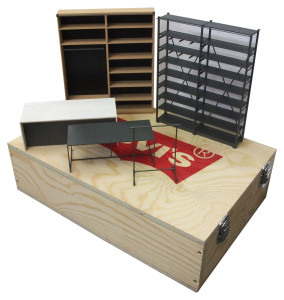 The retail display team recently turned model makers to give Levi’s a preview on new furniture elements.
The retail display team recently turned model makers to give Levi’s a preview on new furniture elements.
Produced by a small architectural practice in the Czech Republic, Triplar commissioned a range of model furniture items to help visualise how full size versions will look in situ. The scale models are based on Triplar’s interpretations of Levi’s designs.
The items, which included two versions of perimeter shelving modules, a denim barge, hangbar and a metal table, have been sent to the brand’s HQ in San Francisco for review ahead of a planned roll-out.
Helping light up retail display
The Triplar factory team have been working on a new retail display technology that promises to introduce cost effective projection mapping to retailers on a global scale.
DisplayMapper has been developed by Projection Artworks, and allows retailers to highlight specific products, visualise ranges, communicate brand messages and change retail environments. Triplar has built display units that help demonstrate what DisplayMapper can do, ahead of the technology’s launch later this month.
Known for their large scale projection projects, this is the first move by Projection Artworks into retail and DisplayMapper is seen as an alternative to the widespread use of LCD screens in stores.
The system uses cloud technology to allow for cost effective projection mapping across hundreds of sites globally.
Find out more at www.displaymapper.com or click the image above to view a video of it in action.
New faces at Triplar

Triplar has welcomed two new team members this summer.
Jason Castleberry joins as European Account Manager. Experienced in the theory, design and engineering of retail environments he has worked with everyone from small boutiques to global retail chains.
Jason will be based in the Czech Republic so that Triplar can benefit from his wealth of experience in the area.
Ewa Sawicka has joined Triplar from local company, Eden, and takes the role of Project Coordinator. She has gained experience within the shop fitting industry working on projects for supermarkets.
Initially Ewa will be working closely alongside Steve McCarthy, in support of an extensive roll-out project for Nike.
Graham Richards, Triplar’s Health and Safety Advisor, has also recently been awarded the NEBOSH National Certificate in Construction Health and Safety. The qualification is aimed at Supervisors, Managers and CDM co-ordinators within the construction industry who are required to ensure that activities under their control are undertaken safely.

